Trouble sleeping? Or just need a cup of calm after a hectic day at work? Chamomile tea is a much-loved tea before bedtime and well known for its sedative effects. You’ve probably tried it already, but do you know all its wonderful health benefits?
Chamomile tea is one of the most popular teas in the world. No wonder since it’s widely available and has sweet and delightful, apple-scented taste. The term “chamomile” actually comes from the Ancient Greek words “kamai” (earth) and melon (apple).
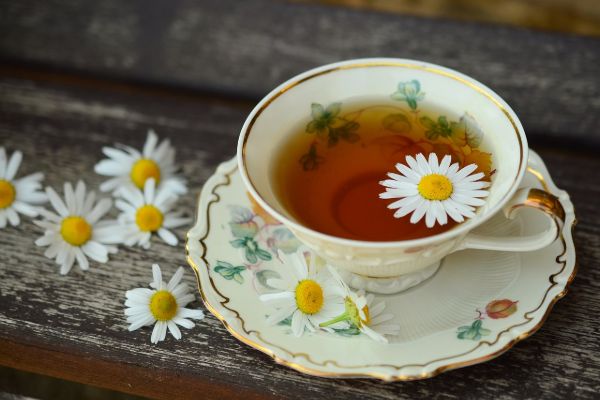
But keep in mind that chamomile tea doesn’t fall under the category of a ‘true tea’ since it does not come from Camellia Sinensis. The good news? No caffeine.
In this article, we’ll look at the many wonderful benefits of chamomile and show you how to brew it from fresh flowers and mix it with other plants. We’ll also show you how to grow the herb. It’s not hard work, don’t worry.
Varieties of Chamomile
There are two key varieties of chamomile you need to know about, and each has its specific uses. So you might as well know the difference!
German Chamomile (Matricaria recutita)
A self-seeding annual, German chamomile has aster flowers that smell like apples, and delicate, ferny leaves. It grows up to 2 feet tall.
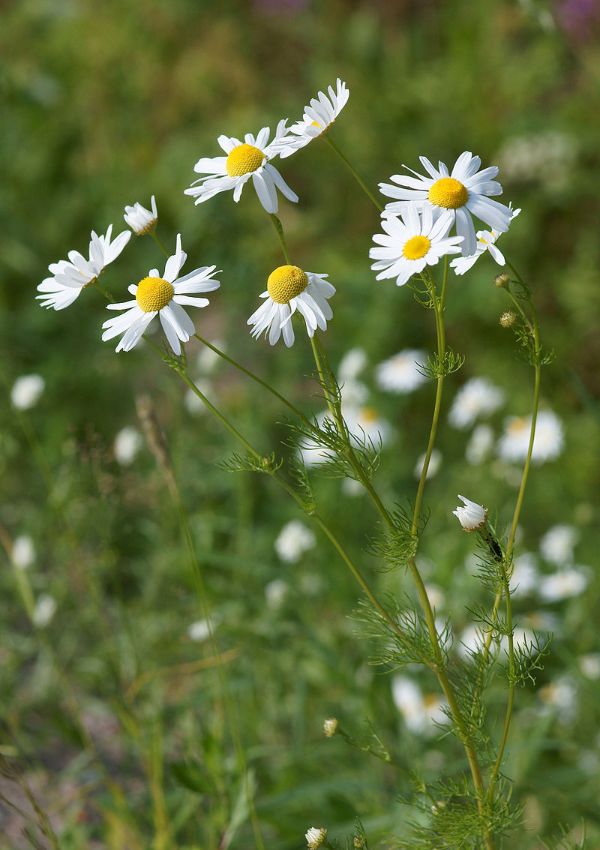
Tea made from German chamomile has a calming, soothing effect on the entire body. It also supports good digestion if you drink it regularly.
This type of chamomile also yields azulene (pronounce it “as you lean”), an essential oil that’s great for calming the skin.
Tip: If you want to grow chamomile in the garden for tea, you want to plant German chamomile. You can also use all parts of the plant in salads, but bits of it can be bitter.
Roman Chamomile (Chamaemelum nobile)
Usually perennial, Roman chamomile is a tiny creeper that will rarely grow beyond 4 inches. It has leaves and flowers that are denser than those of German chamomile.

Roman chamomile can be a cute addition to your garden. You can plant it in between patio pavers or grow a chamomile lawn. Either way, it attracts pollinators that are good for your garden.
Unlike the “German” variant, this type of chamomile doesn’t produce an azulene rich-essential oil. Nor does it produce flowers as often. So it’s not ideal for tea.
The takeaway: German chamomile grows tall and is good for tea. Roman chamomile is better for beautifying your garden.
Chamomile Tea Health Benefits
Chamomile tea is packed with anti-inflammatory properties and has a soothing effect on the central nervous system and the body as a whole.
Here are some of the key health benefits of chamomile tea you need to know about.
1. Induces Calm and Promotes Sleep
This tea is well-known for its power to soothe and reduce stress. It works by activating happy hormones such as serotonin and melatonin. It also contains the antioxidant apigenin, which induces sleepiness.
Chamomile tea helps soothe worries and anxiety. Moreover, it can help relieve headaches or migraines. It can make you fall asleep faster and get a deep rest.
Chamomile serves as a natural cure for mood disorders such as anxiety and depression. It’s even effective in the treatment of Generalized Anxiety Disorder.
2. Soothes Digestion
Another great benefit of chamomile tea is that it helps prevent stomachaches and other problems with the digestive system.
This tea helps relieve gas–that doesn’t sound poetical, but it’s something worth remembering next time a meal doesn’t entirely agree with you (and you have a big meeting coming up).
It also relieves inflammation due to stomach pain and bloating. Chemical compounds in chamomile regulate acid levels, helping to prevent and treat ulcers as well.
3. May Enhance the Immune System
Chamomile tea may boost immune health and strengthen your body’s natural defense mechanism. For this, you have to drink it regularly.
Breathing the fresh scent of chamomile tea can help alleviate congestion and soothe a sore throat. Try it for yourself and you’ll see.
4. May Improve Heart Health
With all those bad fats sneaking into everyday foods, keeping your heart healthy is something of a challenge. But chamomile tea could help with that, too.
A study of diabetic patients found that those who drank chamomile tea had lower bad cholesterol levels.
What’s more, chamomile tea is rich in flavones, a type of antioxidant that can boost heart health.
5. Improves Skin Health
Drinking hot chamomile tea could do miracles not only for your inner health but also for your skin. Think of chamomile tea as a regular skin bleach.
Due to its antioxidant content, it truly helps boost your skin health. Your complexion becomes brighter and gives you fair-glowing skin.
6. Reduces Acne
Chamomile tea could help fight every girl’s nightmare: frequent acne breakout.
With the aid of its anti-inflammatory and antibacterial properties, it may help reduce your spots, acne scars, and combat breakouts.
Tip: You may have apply it directly to the skin before you see benefits.
How to Make Chamomile Tea
Just put a chamomile tea bag in the cup and pour some boiling water over it? Not so fast.
Making chamomile tea using fresh flowers is the better option. You get more antioxidants and health benefits, to say nothing of the apple-like scent. It’s irresistible!
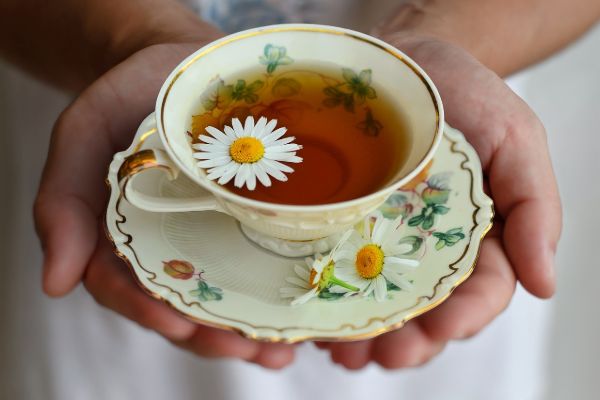
Here’s a simple recipe on how to make chamomile tea using fresh flowers.
Making Fresh Flower Chamomile Tea
Ingredients:
- Fresh chamomile flowers
- 8 ounces of boiling water
- 2 pieces of apple mint leaves (optional)
Tip: Want a stronger scent? Put in more leaves!
Directions:
- Gather the fresh flowers by plucking the entire flower from the stem.
- Wash the flowers in warm water and let them dry. You can store the flowers in the fridge for up to 48 hours if you want. Put the petals in a soaked paper towel and keep in a sealed container.
- Put water to boil in a large pot or tea kettle. Infusion tea kettles are the best option for fresh flower teas since they can keep the petals away from each other.
- Put the flower petals in an infuser and let them steep in the kettle or pot for 5 minutes.
- Take the flower petals out.
- Add mint leaves if you want before pouring the tea into your teacup and enjoy!
Tip: You can also use other infusion devices such as a tea ball or cheesecloth for making cheese. Remember to always use pure or spring water and not tap water to maintain the natural flavor of the tea.
Best Chamomile Tea Recipes
Chamomile tea is a stress-free drink to make and its delicate flavor combines wonderfully with other herbs and spices.
When playing around with chamomile tea variations, using fresh flowers is the best way to provide a super flavor. Read on to discover some of the best recipes using fresh chamomile flowers.
1. Lavender and Chamomile Tea
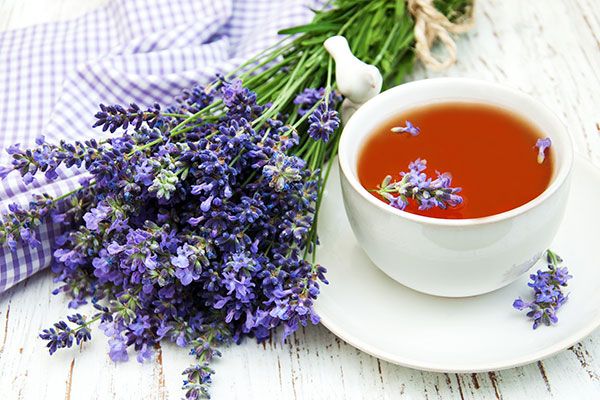
Ingredients:
- 1/2 cup of fresh chamomile flowers (again, more petals for stronger tea)
- 1/2 cup of fresh lavender flowers
- 1/2 cup of apple mint leaves
- 2 whole-juiced lemons (optional)
- 1/4 cup of honey (optional)
Directions:
- Boil water into a large pot or kettle. Cool for 1 minute after removing from heat.
- Put the chamomile flowers, lavender flowers, and mint leaves into a tea ball. Let them infuse in the hot water and steep for 5 minutes.
- Remove the tea ball and strain loose flowers and leaves.
- You can add some lemon juice and honey if you like. Serve while hot!
2. Chamomile and Cinnamon Latte

Ingredients:
- 8 ounces of spring or pure water
- 8 ounces of milk (any kind will do)
- 1 handful of fresh chamomile flowers
- 1 tbsp. of maple syrup
- 1/2 tsp. of ground cinnamon
Directions:
- Boil water in a medium saucepan.
- Remove heat then add the chamomile flowers. Steep for 5 minutes.
- Next, pour some maple syrup and add some cinnamon.
- Heat and turn the milk into a whip by using a milk frother, an espresso machine, or a hand frother. In case you don’t have any of these, just heat the milk in another pan and whisk briskly.
- Continue whisking until little bubbles form and the milk becomes fizzy.
- Mix the water potion and milk into a cup. Add some milk foam to the top of the mug. Sprinkle with cinnamon and enjoy the treat!
3. Chamomile Ginger Iced Tea

Ingredients:
- 8 cups of water
- 1 fresh ginger (2 inches)
- 2 cups of fresh chamomile flowers
- 4 tbsp. of honey
- 2 freshly squeezed lemons
Directions:
- Have a medium saucepan to get water to a quick simmer. Let heat subside and cool for 1 minute.
- Combine chamomile flowers, ginger, lemons, and honey. Steep until the tea cools down to room temperature.
- In a large glass pitcher, strain the tea. Store in the refrigerator for 3 hours.
- Prepare tall glasses with ice cubes and pour the tea.
- Relish with a lemon slice and fresh chamomile flower.
How to Grow Chamomile Herb at Home
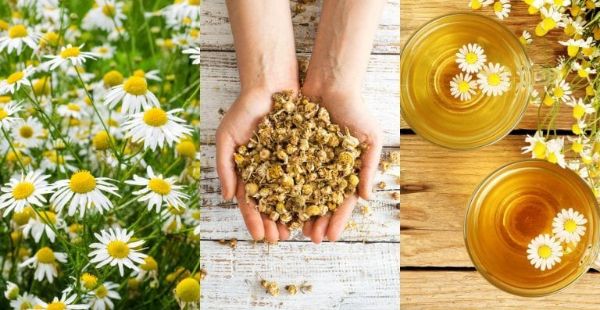
Growing chamomile in your garden is not such a big deal. You’re looking at a humble plant that doesn’t need much in terms of care.
Here are the easy steps you need to follow to get started.
Method 1: Growing Chamomile Seeds Indoors

1. Begin growing indoor chamomile seeds in the last days of winter
You can start seeds indoors around six weeks before the last expected cold weather in your area.
Light is necessary for germination, so simply scatter the seeds and scratch them into the soil.
For faster sprouting, leave the seeds uncovered. Usually, it takes about seven to fourteen days for chamomile seeds to develop.
2. For sowing, grab a multi-container tray
Get a seeding tray that has several tiny containers. You can use them to do multiple plantings all at once.
3. Make the seed sowing compost damp in the containers
You can buy soil mix specially made for growing seeds. Fill each container about ¾ of its capacity and dampen the soil well.
4. Cover the seeds lightly with little soil
Put about 6 chamomile seeds in each container. Have them covered lightly with just enough soil to keep them protected from curious eyes.
5. Water the containers using a spray bottle or a sprinkler
Make sure to moist the soil. Keep checking on the seeds daily to ensure the soil is moist, but not soaked.
Tip: Sprinkle water on the seeds about once a day.
6. Change the temperature to promote germination
The best temperature for growing the seeds is between 65-85℉. During the daytime, raise up the temperature a bit by moving the plants in a sunny spot. At night, keep them in a cooler spot.
7. Cut one seedling when plants are 2 inches high
This process will leave one healthy seedling in one container. Cut seedlings to thin them.
Important: Do not pull their roots so as not to disturb their growth.
8. Ready your plants for transplanting
Prepare your plants for their life outside by moving them out of the house and keeping them under shade for a few hours every day.
Expose them gradually to more of the outdoors every day for two weeks.
9. Transfer the plants once all danger of extreme cold is done
About six weeks after starting your seeds, you’re ready to move the plants to their new home in the garden.
When removing sprouts, keep in mind to space them about 8 to 10 inches apart in the lawn bed.
Tip: Add to the holes a combination of soil and slow-release fertilizer to drive healthy growth.
Method 2: Growing Chamomile Outdoors

1. Find a warm and sunny spot for your chamomile
The plant will blossom at its finest under full sun. But if you live in a region with scorching weather, go for partial shade to ensure your plants have some protection from the heat.
2. Use a rake to smooth the soil
Prepare the soil by raking the area to remove any rocks, clumpy soil, or any weeds you come across.
Go at least 1 foot deep and then put the soil back and prep for it for an even planting surface.
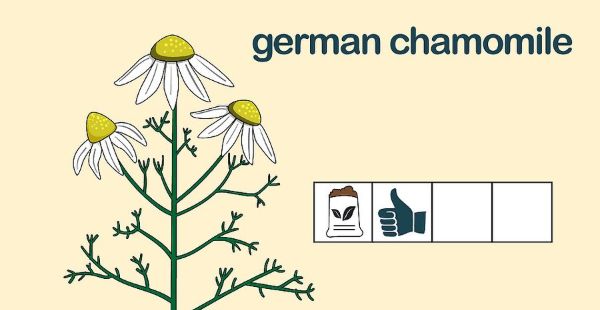
3. Choose German chamomile if you have low-quality soil
German chamomile will thrive even in low-nutrition soil.

4. Opt for Roman chamomile if you have good, fertile soil
Roman chamomile blooms best in high-quality soil. This variety is a perennial, so it does not need replanting every year.
Tip: But bear in mind that German chamomile is usually better for tea.

5. Plant your seeds in the last days of spring or summer to prevent frost
Make sure the season of cold temperature has passed before sowing your seeds. This varies depending on where you live.
6. Pour the seeds gently on top of the soil
Sprinkle the seeds all over the soil. Gently cover them with only a small amount of soil. They will germinate better if the sunlight reaches them.
Tip: Make sure you can still see the seeds even when they are covered. If you can’t, you’ve planted them too deep.

7. Water the seeds until the soil is wet enough
After your plants have adjusted to the outdoors, consistent watering will help them grow more blossoms.
Tip: Since chamomile is a drought-tolerant bush, it can survive without water so don’t worry if you forget to water them now and then.
8. Cut seedlings when they are 2 inches tall
Make some space of about 8 to 10 inches between seedlings. Make sure to cut the seedlings at ground level. Don’t cut the roots!
When to Harvest Chamomile
Gather the chamomile flowers once they are completely open. You can use these aromatic flowers fresh or withered. You can even store them in a tea box and keep them in a cool, shaded place for use later.

Tip: The leaves can make your drink bitter, so you may want to leave them out and harvest only the flowers. Try infusing the leaves first and see how that goes.
Common Chamomile Tea Questions Answered
Does chamomile tea really help fight insomnia?
Chamomile tea contains apigenin, a flavonoid that induces peaceful, uninterrupted sleep. It’s great for people who have sleeping problems or suffer from insomnia.
How long before bed should you drink chamomile tea?
The ideal time to drink this tea is about 30 minutes before bed. It’s a mild tranquilizer and sleep-inducer. The tranquilizing effect is the result of its flavonoid content.
Is it safe to drink chamomile tea every night?
Chamomile tea is a safe brew to have before you go to bed every night. It’s considered a tisane or non-caffeinated brew, so drinking it before bedtime will not keep you up at night.
How many cups of chamomile tea can I drink a day?
There is no clear limit. You can make and drink as much chamomile tea as you want. But if you take chamomile in daily capsule form, 400 milligrams to 1,600 milligrams is usually the right amount.
What are the side effects of chamomile tea?
Potential side effects of chamomile tea include allergic reaction, skin reactions or irritations, hypersensitivity reactions, and nausea or vomiting (only in excess dosages). But these side effects are rare and the benefits of chamomile tea far outweigh them.
Now How About a Cup of Chamomile Tea?
Chamomile tea doesn’t have caffeine and comes with lots of health benefits. And it tastes great, too.
The best part is that growing your own chamomile herb at home in the garden or indoors isn’t a big deal. You just need a bit of space for it and nature takes care of the rest.
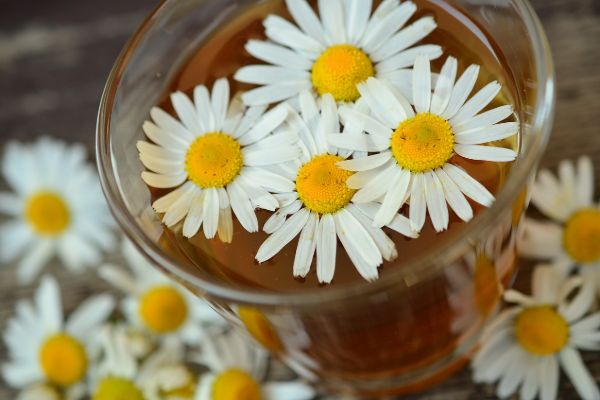
So, when’s the last time you drank chamomile tea? Last year? Or last night? Why don’t you try a cup now?
Try one of the chamomile tea recipes we shared with you and come back to us to let us know whether you liked it. We’d love to hear from you!

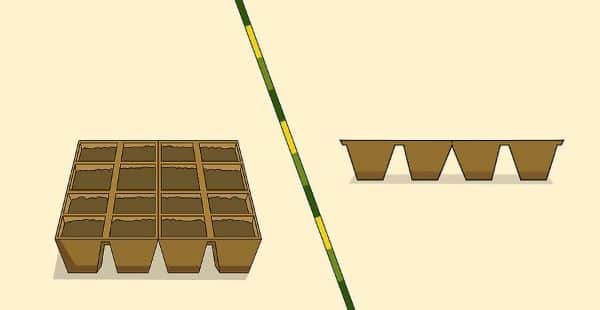



Leave a Reply